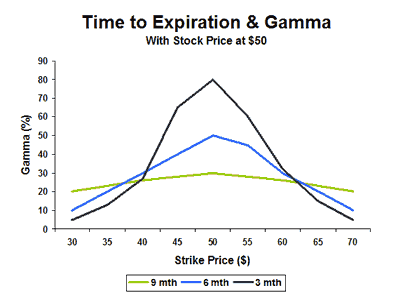
The Gamma is one of the most important Options Greeks.
It generally is at its peak value when the stock price is near the strike of the option and decreases as the option goes deeper into or out of the money. Options that are very deeply into or out of the money have gamma values close to 0.
Effect of volatility and time to expiration on gamma
Gamma is important because it shows us how fast our position delta will change as the market price of the underlying asset changes.
When volatility is low, the gamma of At-The-Money options is high while the gamma for deeply into or out-of-the-money options approaches 0. The reason is that when volatility is low, the time value of such options are low but it goes up dramatically as the underlying stock price approaches the strike price.
When volatility is high, gamma tends to be stable across all strike prices. This is due to the fact that when volatility is high, the time value of deeply in/out-of-the-money options are already quite substantial. Thus, the increase in the time value of these options as they go nearer the money will be less dramatic and hence the low and stable gamma.
As the time to expiration draws nearer, the gamma of At-The-Money options increases while the gamma of In-The-Money and Out-of-The-Money options decreases.

How to put gamma work for you
In simple terms, the gamma is the option's sensitivity to changes in the underlying price. In other words, the higher the gamma, the more sensitive the options price is to the changes in the underlying price.
When you buy options, the trade has a positive gamma - the gamma is your friend. When you sell options, the trade has a negative gamma - the gamma is your enemy. The closer we are to expiration, the higher is the gamma.
When you buy options and expect a significant and quick move, you should go with closer expiration. The options with closer expiration will gain more if the underlying moves. The tradeoff is that if the underlying doesn't move, the negative theta will start to kick off much faster.
When you sell options, you have negative gamma that will increase significantly as the options approach expiration. This is the biggest risk of selling weekly options.
Should you trade weekly options?
Selling options with closer expiration will give you higher positive theta per day but higher negative gamma. That means that a sharp move of the underlying will cause much higher loss. So if the underlying doesn't move, then theta will kick off and you will just earn money with every passing day. But if it does move, the loss will become very large very quickly. Another disadvantage of close expiration is that in order to get decent credit, you will have to choose strikes much closer to the underlying.
As we know, there are no free lunches in the stock market. Everything comes with a price. When the markets don't move, trading close expiration might seem like a genius move. The markets will look like an ATM machine for few weeks or even months. But when a big move comes, it will wipe out months of gains. If the markets gap, there is nothing you can do to prevent a large loss.
Does it mean you should not trade weekly options? Not at all. They can still bring nice gains and diversification to your options portfolio. But you should treat them as speculative trades, and allocate the funds accordingly. Many options "gurus" describe those weekly trades as "conservative" strategy. Nothing can be further from the truth.
Example
Lets sat you have a call with a delta of .60. If the price of the underlying security rises by $1, then the price of the call would therefore rise by $.60. If the gamma value was .10, then the delta would increase to .70. This means that another $1 rise in the price of the underlying security would result in the price of the option increasing by $.70, and the delta would also increase again in accordance with the gamma.
This highlights how moneyness affects the delta value of an options contract, because when the contract gets deeper into the money, each price movement of the underlying security has a bigger effect on the price. The gamma is also affected by moneyness, and it decreases as an in the money contract moves further into the money.
This means that as a contract gets deeper into the money, the delta continues to increase but at a slower rate. The gamma of an out of the money contract would also decrease as it moved further out of the money. Therefore, gamma is typically at its highest for options that are at the money, or very near the money.
List of gamma positive strategies
- Long Call
- Long Put
- Long Straddle
- Long Strangle
- Vertical Debit Spread
List of gamma negative strategies
- Short Call
- Short Put
- Short Straddle
- Short Strangle
- Vertical Credit Spread
- Covered Call Write
- Covered Put Write
- Iron Condor
- Butterfly
- Long Calendar Spread
Summary
- Gamma measures the rate of change for delta with respect to the underlying asset's price.
- All long options have positive gamma and all short options have negative gamma.
- The gamma of a position tells us how much a $1.00 move in the underlying will change an option’s delta.
- We never hold our trades till expiration to avoid increased gamma risk.
Watch the video:
Related articles:
- The Options Greeks: Is It Greek To You?
- Options Trading Greeks: Theta For Time Decay
- Options Trading Greeks: Delta For Direction
- Options Trading Greeks: Vega For Volatility
- Why You Should Not Ignore Negative Gamma
- Short Gamma Vs. Long Gamma
Want to learn how to put the Options Greeks to work for you? Join Us



Join the conversation
You can post now and register later. If you have an account, sign in now to post with your account.
Note: Your post will require moderator approval before it will be visible.